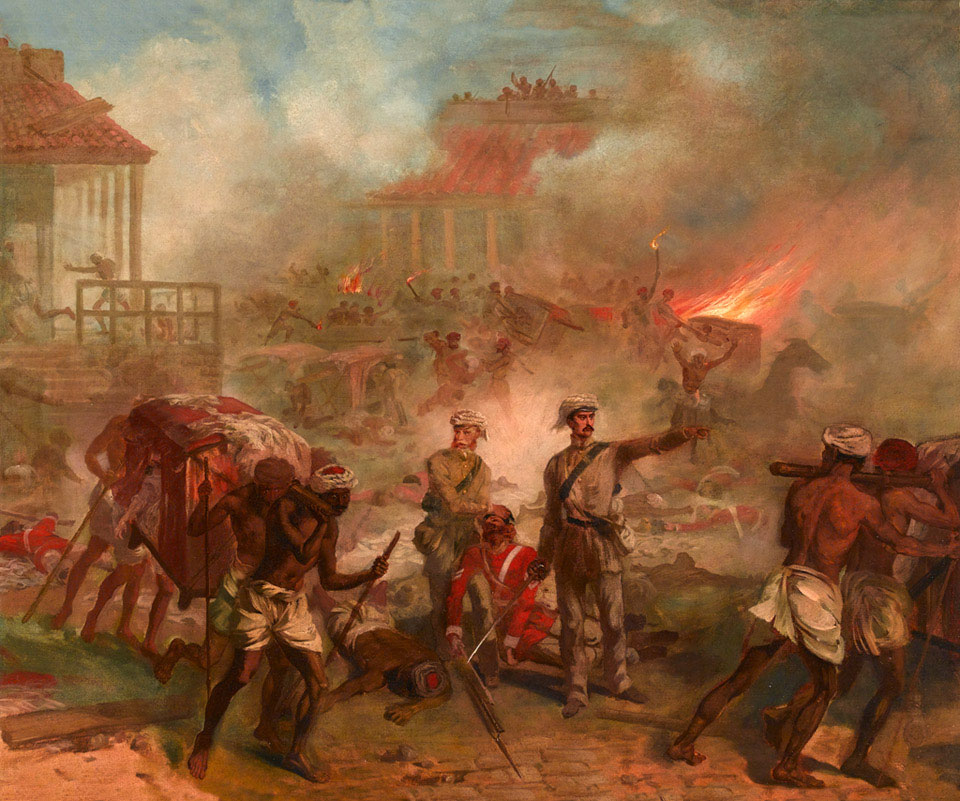
ESANGES, Louis William, is the great grandson of a French marquis, who, like others of the French noblesse, was compelled by political troubles to seek a home in England, and where he became naturalized.
The subject of our notice was born in London in 1822, and at the age of six was taken by his parents to Florence, where he received his first drawing-lesson, the family remaining there for two years. In 1831 he returned to England, and was sent to Hazlewood School at Birmingham, whence, at the expiration of a year, he was transferred to Hall Place School, Bexley, Kent, where he remained six years, continuing his drawing studies under the direction of Mr. James Stone, son of the principal, and a pupil of John Varley. To Mr. Stone the late A. L. Egg, R.A., and many young men who have since attained high rank in the military and naval service of the country were also indebted for their early instruction in drawing.
At the age of sixteen Mr. Desanges went to France, and studied for a short time under Grobon, at Lyons. After again visiting Florence, and extending this time his travels to Rome and Naples, he returned to England in 1845. It was about this period that the artists of our country were called upon to compete for the honour of decorating the newly-erected Houses of Parliament with pictures; Mr. Desanges cast in his lot with the others, by sending an oil-painting to Westminster Hall, but he failed to secure a prize. In 1837 a number of artists, considering it a fair opportunity for the exhibition of their works was not allowed to them at the Royal Academy and other long-established galleries, tried the experiment of opening, first at the Egyptian Hall, and secondly at the Chinese Gallery, Knightsbridge, a Free Art-Exhibition, which, after three or four seasons, was removed to Portland Street, and took the successive titles of the "Portland Gallery," and the "National Institution." This society died a natural death in 1862. During two years of its infancy Mr. Desanges contributed to it, sending several pictures which attracted favourable notice; among them The Sleeping Fountain, Cupid, and Psyche, two small compositions, powerful in colour, and very charming in effect; a Bacchante, a female head wearing a coronal of grapes and vine-leaves, originally and beautifully treated; and a far more important work than either of these, The Ex-communication of Robert, King of France, and his Queen, Bertha, a large composition, thronged with figures of great variety of character, all powerfully expressive, and many energetic in action. 1846 Mr. Desanges exhibited at the Academy a portrait of a young lady, but did not make his appearance again in the same gallery till 1851, when he sent a portrait of the Duchess of Manchester. From this period almost each successive year has seen two or three works of this kind from his easel; among which have been portraits of the Duchess of Montrose, Lady Olivia Ossulston, the Marquis of Graham, eldest son of the Duke of Montrose, Lady Bolton, the children of Lord and Lady Bolton, the Viscountess Folkstone, the Hon. Mrs. John Dundas, the Viscountess Glamis, Miss Thorold, Lady Palk, the Hon. Lady Abercromby, the infant daughter of Lord and Lady Londesborough, under the title of The Golden Age, Miss Drummond Davis, the Hon. A. L. Powlett, Mrs. Forbes Winslow, and many others. In 1854 the artist sent to the Academy a large equestrian portrait of Victor Emanuel, but it was not hung, and has since been sent to Nice, and placed in the Hotel de Ville there.

Surgeon Anthony Dickson Home and Assistant Surgeon William Bradshaw, 90th Regiment of Foot (Perthshire Volunteers) (Light Infantry), Lucknow, 1857, by Desanges.
Upon the institution of the Order of the Victoria Cross by Her Majesty, Mr. Desanges hit upon the idea of commemorating the valorous feats of arms in the Crimea and in India, upon the heroes of which that distinction was conferred; and in 1859 opened an exhibition of twenty-four pictures, called the "Victoria Cross Gallery," to which he afterwards added until the number reached fifty. These performances, which display considerable spirit, as well as artistic skill, were in 1863 transferred to the Crystal Palace, whence, we believe, they passed into the hands of a private collector. [Bryan 51-52]
Supplementary Note
Not mentioned in this otherwise useful account is any detail of Louis Desanges' personal life, or, of course, of his later years.
Desanges was a freemason, and very much part of the artistic scene in London: he married Eleanor, daughter of Robert Furner, Esq., of Fitzroy Square, on 30 October 1856 at St Marylebone Church, and their family included daughters Eleanor Fanny (Nelly), Beatrice, and Edith Maud, who can be spotted here and there in private diaries and records, including the peerage. Lewis Carroll, for instance, met Desanges's wife and Nelly, with a whole set of artist friends, at a Moray Lodge garden party on 11 June 1869 (II: 281). On 16 September 1871 he also visited them on the Isle of Wight (II: 323). Nelly married a prominent lawyer, Charles Bousfield Shaw, on 15 November 1877. Edith Maud, fittingly, married an officer, becoming the second wife of General Rt Hon. Sir Henry Brackenbury (see The Peerage, 1900). Desanges, whose project of painting national heroes had attracted the attention of the Prince of Wales, has several paintings in the Royal Collection.
Desanges died in West Drayton in Middlesex in 1905, his wife living on until 1919. — Jacqueline Banerjee
Bibliography
Bryan, Michael. A Biographical and Critical Dictionary of Painters and Engravers.... Edited by George Stanley. London: George Bell, 1878. Google Books. Free ebook.
Carroll, Lewis The Diaries of Lewis Carroll
The Peerage, Baronetage, Knightage & Companionage of the British Empire for 1907). Edited by Edmund Lodge. Google Books. Free ebook.
Created 28 August 2024